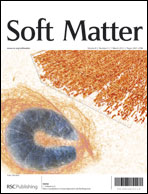Anisotropic liquid penetration arising from a cross-sectional wettability gradient†
Abstract
Using a simple membrane model composed of spaced microcylinders, we show unambiguously that a wettability gradient along the thickness direction can cause anisotropic liquid penetration behavior, which is attributed to the coupled effects of local geometrical angle and contact angle on the critical breakthrough pressure. The anisotropic ratio of critical breakthrough pressure can be improved by reducing the spacing ratio of the cylinder membrane as well as by increasing the wettability gradient. This kind of gradient membrane with anisotropic penetration resistance to liquid may open up new applications in fluid control, membrane separation and advanced fabrics.


 Please wait while we load your content...
Please wait while we load your content...